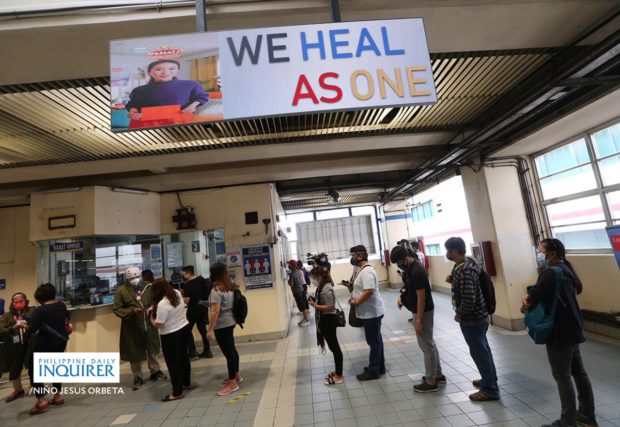
Passengers show their vaccination cards upon entering the Metro Rail Transit Line 3 at Edsa-North Avenue Station. (INQUIRER file photo / Niño Jesus Orbeta)
MANILA, Philippines — As people in Metro Manila and 38 other areas eagerly welcome the move to the most relaxed Alert Level 1 starting today, Malacañang cautioned that vaccination and compliance with minimum health protocols must continue to avoid another spike in infections and a return of quarantine restrictions.
“Our reaching Alert Level 1 may be regarded as a victory but this is not yet the time to celebrate. We need to be responsible to ourselves, our families, and our communities. Even if we have controlled it, the threat of COVID-19 remains in our midst,” Cabinet Secretary Karlo Nograles, acting presidential spokesperson, said in his press briefing on Monday.
He said the Alert Level 1 status, described by the government as the “new normal,” was achieved because the people cooperated with the government, complied with regulations, took care of their health, and got vaccinated.
Nograles appealed to the fully vaccinated to get their booster shots and to parents with children aged 5 to 11 to have them inoculated.
Health Undersecretary Maria Rosario Vergeire added that the pandemic was not yet over as it had yet to reach the endemic stage.
“What the endemic state means is that the virus will be around, will be with us in our lives but the number of cases or even deaths will be acceptable to our society or to us Filipinos,” she said.
“We will get to the point that the cases will be predictable and manageable, and secondly, when the vaccination coverage in our country will be high, which can balance off the level of transmission of COVID-19. When we reach that level, we can already say that it’s endemic already,” she added.
People, Vergeire said, should be prudent and must “self-regulate” by avoiding or being extra careful in going to crowded places and mass gatherings where masking and physical distancing are not being observed.
“I’d like to encourage everybody, sustaining this alert level 1 is in our hands. We don’t want to return to lockdowns, to the restrictions before, so self-regulation is the key. Let us help by complying with safety protocols,” she said.
Weekly case update
The government is also changing its reporting method on the coronavirus situation to make people less jittery about it.
Starting next week, the Department of Health (DOH) will come out with a weekly report of the COVID-19 situation in the country, effectively scrapping its daily case bulletin that it adopted since the start of the pandemic in 2020.
All weekly updates will be released every Monday at 4 p.m., according to the DOH.
“The objective has to be clear. We have to move away from too much number-centric reporting to really analyzing what all this means by highlighting data or statistics that truly matter without unnecessarily instilling fear into the hearts of the public,’’ Health Secretary Francisco Duque III told a meeting with editors of media outlets.
Duque lamented that the daily breaking news of the number of new infections was not helping inspire public confidence.
Vergeire agreed on the need to “remove the mindset of people on numbers.’’
She said with cases continuously going down and with 63 million Filipinos now fully vaccinated against the virus, the DOH would now focus on reporting only the number of severe and critical cases as well as those occupying the intensive care units of hospitals.
The DOH on Monday reported 951 new COVID-19 cases, the lowest daily case count recorded this year.
The last time the country saw less than 1,000 infections was on Dec. 29, 2021, when 889 cases were reported.
The national caseload, according to DOH data, was now 3,661,997.
The DOH said there were 52,179 active cases, of which 47,157 were mild.
The 1,717 recoveries brought the total number of survivors to 3,553,367, while the 50 fatalities raised the death toll to 56,451, the DOH said.
Getting ready
Other government agencies are also preparing for increased economic activity under alert level 1.
The Philippine Coast Guard (PCG) said it would augment its personnel and operational requirements in major seaports and tourist destinations due to an expected spike in maritime-related activities.
PCG officer in charge Vice Adm. Eduardo Fabricante said these destinations include Boracay, Palawan, Cebu and Bohol, as well as other provinces with popular resort islands and coastal vacation spots.
The Department of Tourism (DOT) said the lowering of the alert level in various areas across the country could further boost travel and tourism activities.
Meanwhile, director Tina Cassion of the Land Transportation Franchising and Regulatory Board stressed that while both mass and public transportation are allowed 100-percent seating capacities under alert level 1, buses and jeepneys are not allowed to accommodate standing passengers.
For the Metro Rail Transit 3, which traverses Edsa, a 100-percent passenger capacity means 394 passengers per train car or 1,182 passengers per train set, she said.
Metropolitan Manila Development Authority general manager Romando Artes said the weekday 5 p.m. to 8 p.m. number coding scheme would also be retained but the agency was already studying whether to enforce this from 7 a.m. to 9 a.m. to reduce vehicle congestion during the morning rush hour.
More people are likewise expected to attend in-person Masses, especially on Ash Wednesday, which marks the start of the Lenten season.